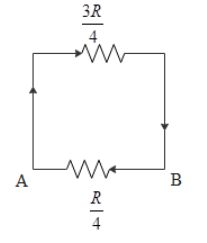
Answer
427.2k+ views
Hint: Here the four resistors R on each side are in parallel. Thus first calculate the equivalent resistance for each side. Then re arrange the diagram using the calculated value. Then we will get a series connection across the resistor AB. Then the series resistor will be parallel to the resistor across AB. Hence, the resultant value of those two parallel resistors will be the net resistance across AB. Hence while calculating the equivalent resistance, first note whether it is connected in series or parallel. Then use the suitable equation of the given circuit.
Complete answer:
Here all resistance is $R=16\Omega $ on each parallel side.
Thus equivalent resistance of each side is,
Four resistors are connected parallel on each side.
Hence,
$\dfrac{1}{{{R}_{eq}}}=\dfrac{1}{R}+\dfrac{1}{R}+\dfrac{1}{R}+\dfrac{1}{R}$
$\begin{align}
& \Rightarrow \dfrac{1}{{{R}_{eq}}}=\dfrac{4}{R} \\
& \Rightarrow {{R}_{eq}}=\dfrac{R}{4} \\
\end{align}$
This is the equivalent resistance for one side. Since the equivalent resistance on four sides are equal, the equivalent resistance on four sides are equal to $\dfrac{R}{4}$.
Thus the resultant circuit becomes,

Here the three resistors are connected in series to the resistor connected between AB.
Hence the resistance for the series connection is,
$\begin{align}
& {{R}^{'}}=\dfrac{R}{4}+\dfrac{R}{4}+\dfrac{R}{4} \\
& \Rightarrow {{R}^{'}}=\dfrac{3R}{4} \\
\end{align}$
Then the resistors ${{R}^{'}}$ and ${{R}_{eq}}$ becomes parallel.
Thus the resultant circuit becomes,

Therefore the net resistance between A and B is,
$\dfrac{1}{{{R}_{AB}}}=\dfrac{1}{\left( \dfrac{3R}{4} \right)}+\dfrac{1}{\left( \dfrac{R}{4} \right)}$
$\begin{align}
& \Rightarrow \dfrac{1}{{{R}_{AB}}}=\dfrac{4}{3R}+\dfrac{4}{R} \\
& \Rightarrow \dfrac{1}{{{R}_{AB}}}=\dfrac{4}{3R}+\dfrac{4\times 3}{3R} \\
& \Rightarrow \dfrac{1}{{{R}_{AB}}}=\dfrac{16}{3R} \\
& \Rightarrow {{R}_{AB}}=\dfrac{3R}{16} \\
\end{align}$
Given that $R=16\Omega $
Hence,
$\begin{align}
& {{R}_{AB}}=\dfrac{3\times 16}{16} \\
& \Rightarrow {{R}_{AB}}=3\Omega \\
\end{align}$
Note:
The net resistance in a series connection is the sum of resistances connected in the given circuit. Whereas, the net resistance in a parallel connection, that is the reciprocal of equivalent resistance is the sum of reciprocals of the individual resistances. Hence while calculating the equivalent resistance, first note whether it is connected in series or parallel. Then use the suitable equation of the given circuit.
Complete answer:
Here all resistance is $R=16\Omega $ on each parallel side.
Thus equivalent resistance of each side is,
Four resistors are connected parallel on each side.
Hence,
$\dfrac{1}{{{R}_{eq}}}=\dfrac{1}{R}+\dfrac{1}{R}+\dfrac{1}{R}+\dfrac{1}{R}$
$\begin{align}
& \Rightarrow \dfrac{1}{{{R}_{eq}}}=\dfrac{4}{R} \\
& \Rightarrow {{R}_{eq}}=\dfrac{R}{4} \\
\end{align}$
This is the equivalent resistance for one side. Since the equivalent resistance on four sides are equal, the equivalent resistance on four sides are equal to $\dfrac{R}{4}$.
Thus the resultant circuit becomes,

Here the three resistors are connected in series to the resistor connected between AB.
Hence the resistance for the series connection is,
$\begin{align}
& {{R}^{'}}=\dfrac{R}{4}+\dfrac{R}{4}+\dfrac{R}{4} \\
& \Rightarrow {{R}^{'}}=\dfrac{3R}{4} \\
\end{align}$
Then the resistors ${{R}^{'}}$ and ${{R}_{eq}}$ becomes parallel.
Thus the resultant circuit becomes,

Therefore the net resistance between A and B is,
$\dfrac{1}{{{R}_{AB}}}=\dfrac{1}{\left( \dfrac{3R}{4} \right)}+\dfrac{1}{\left( \dfrac{R}{4} \right)}$
$\begin{align}
& \Rightarrow \dfrac{1}{{{R}_{AB}}}=\dfrac{4}{3R}+\dfrac{4}{R} \\
& \Rightarrow \dfrac{1}{{{R}_{AB}}}=\dfrac{4}{3R}+\dfrac{4\times 3}{3R} \\
& \Rightarrow \dfrac{1}{{{R}_{AB}}}=\dfrac{16}{3R} \\
& \Rightarrow {{R}_{AB}}=\dfrac{3R}{16} \\
\end{align}$
Given that $R=16\Omega $
Hence,
$\begin{align}
& {{R}_{AB}}=\dfrac{3\times 16}{16} \\
& \Rightarrow {{R}_{AB}}=3\Omega \\
\end{align}$
Note:
The net resistance in a series connection is the sum of resistances connected in the given circuit. Whereas, the net resistance in a parallel connection, that is the reciprocal of equivalent resistance is the sum of reciprocals of the individual resistances. Hence while calculating the equivalent resistance, first note whether it is connected in series or parallel. Then use the suitable equation of the given circuit.
Recently Updated Pages
How many sigma and pi bonds are present in HCequiv class 11 chemistry CBSE

Mark and label the given geoinformation on the outline class 11 social science CBSE

When people say No pun intended what does that mea class 8 english CBSE

Name the states which share their boundary with Indias class 9 social science CBSE

Give an account of the Northern Plains of India class 9 social science CBSE

Change the following sentences into negative and interrogative class 10 english CBSE

Trending doubts
Difference between Prokaryotic cell and Eukaryotic class 11 biology CBSE

Which are the Top 10 Largest Countries of the World?

Differentiate between homogeneous and heterogeneous class 12 chemistry CBSE

Fill the blanks with the suitable prepositions 1 The class 9 english CBSE

Difference Between Plant Cell and Animal Cell

Give 10 examples for herbs , shrubs , climbers , creepers

The Equation xxx + 2 is Satisfied when x is Equal to Class 10 Maths

Write a letter to the principal requesting him to grant class 10 english CBSE

Change the following sentences into negative and interrogative class 10 english CBSE




